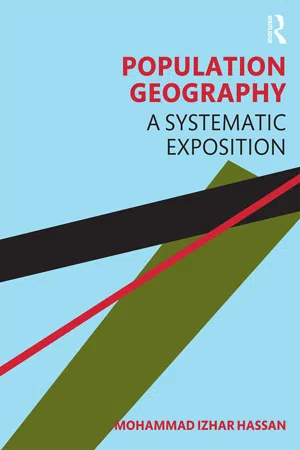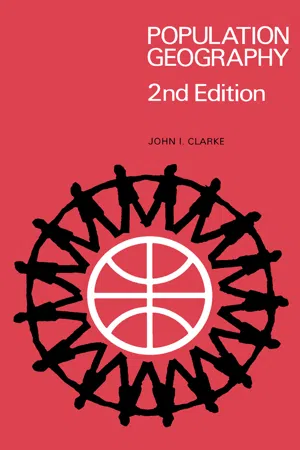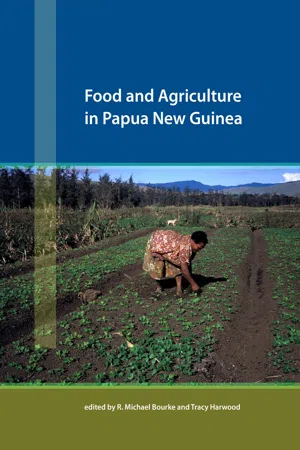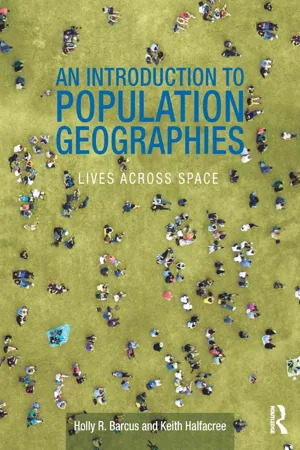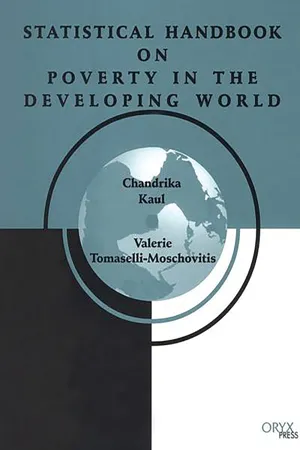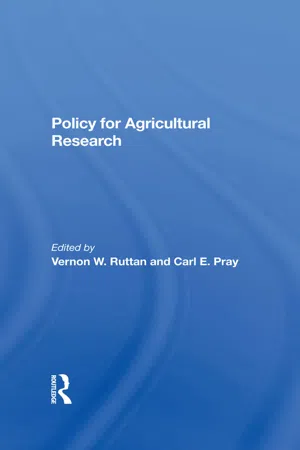Geography
Agricultural Population Density
Agricultural population density refers to the number of rural inhabitants per unit of agriculturally productive land. It provides insight into the relationship between population distribution and agricultural resources. This measure is important for understanding the pressure on agricultural land and the potential impact on food production and rural livelihoods.
Written by Perlego with AI-assistance
Related key terms
1 of 5
10 Key excerpts on "Agricultural Population Density"
- eBook - ePub
Population Geography
A Systematic Exposition
- Mohammad Izhar Hassan(Author)
- 2020(Publication Date)
- Routledge India(Publisher)
In the case of Egypt, while the crude density is only 93, physiological density works out to be nearly 3,498 thousand persons per square kilometres of arable land according to PRB, 2017. This measure is very appropriate for a situation where agriculture is the mainstay of population. But it is also true that not all the people in a region or country are dependent on agriculture. Thus, physiological density also does not provide an accurate picture of population pressure on land. As a further refinement, agricultural density is worked out which refers to a ratio between the number of people earning their living or subsistence from working the land and the total amount of farmland. In the economically advanced countries, agricultural densities are very low as compared to the less advanced countries. As cultivable and cultivated areas of a region or country are generally not of uniform value, agricultural density does not provide an exact account of man-land relations. Vincent, a French geographer, in 1946, therefore, suggested an index, which he termed as comparative density (Clarke, 1972:30). In the calculation of comparative density, total population of a region is related to the aggregate of weighted land under cultivation according to its productivity. Thus, it is type of physiological density taking into account the varying levels of productivity of cultivated lands in any area. It is worthwhile to note here that the measures of density discussed earlier are of no practical value for areas which are more urbanised and industrialised. In the developed countries of the West vertical expansions of residential complexes invalidate the relationship between population and areas, and these measures, therefore, reveal nothing about the concentration of people within buildings - eBook - PDF
- Rodolfo B. Valdenarro(Author)
- 2019(Publication Date)
- Delve Publishing(Publisher)
Figure 6.3: Agricultural density is defined as the field of study that explains the ration between, the farmers and the availability of the farmland in that area. Source: https://www.nps.gov/heho/learn/images/heho_aquatic_ monitoring_2014_2x1ratio.jpg?maxwidth=1200&maxheight=1200&autor otate=false Agricultural density is defined as the proportion that is available in a specified region of the number of the individuals who farm comparative to the amount of farmable land that is available. On the other hand, nutritional density is defined as the percentage among the total amount of farmland and total population of the area. Age/sex pyramids offer the graphic pictures comparative to the demographics of an area, a country, or a place. The areas with high birth rates as well as high expiry rates will generally have trilateral or triangular shaped pyramids, representing that the average age of the population of the area is young. On the other hand, the areas with lower birth rates as well as lower death rates will not have triangular shaped pyramid, but it will have population pyramids with sides that are far more vertical, thus representing that the average age of population of the area is higher. The average age of a population (number of youth individuals comparative to number of older Applied Human Geography 126 individuals) is usually a dependable pointer of area’s potential for natural (not counting immigration) growth of population. If most of the population of an area is in the child-bearing years or younger, the potential for the development is great. On the other hand, if the popula-tion of an area is normally older, the population’s potential growth is lesser. - eBook - PDF
Population Geography
Pergamon Oxford Geographies
- John I. Clarke, W. B. Fisher(Authors)
- 2013(Publication Date)
- Pergamon(Publisher)
30 Population Geography cultivable, cultivated or crop areas, or an area weighted according to its land use. By the dasymetric techniques devised by Wright, densities are calculated only for the inhabited areas, the remaining areas being left blank on popu-lation maps. Densities are also calculated for cultivable areas, and are known in France as phynological densities. They are preferable to crude densities for a country like Egypt, where 96 per cent of the population inhabit about 4 per cent of the total area, but they must be used judiciously, as land which is not cultivable is not necessarily unproductive. Moreover, in some countries statistics of cultivable land are not available; in others cultivable and cultivated land are not distinguished. Similar objections may be levelled at indices of population density per unit of cultivated or crop area (which are diflferent in regions of multiple cropping), but they are more realistic indices where agricultural populations are confined to small proportions of total land areas, as in the Caribbean. When only the agricultural population is taken into the calculations, this density is sometimes called the agricultural density. In Britain, where less than 5 per cent of the active population are employed in agriculture, the agricultural density may be of greater interest than densities of total population per unit of cultivable or cultivated land. By European standards our agricultiural density is very low, and somewhat surprisingly is similar to that of Canada. On the other hand, it is not easy to define the agricultural population. Do we include only active males employed in agriculture, or should we also evaluate the work of women, children and old people, all of whom may play a very useful part in some countries ? Whatever the details, comparisons of agricultural densities, say of the Fens and Cheshire Plain, have more interest than comparisons of crude densities. - eBook - PDF
- Julieta Arjona Sumague(Author)
- 2020(Publication Date)
- Society Publishing(Publisher)
Arithmetic Density (1981–2011) Arithmetic density is the most common kind of population density. Arithmetic density is defined as a simple ratio between total population and the total land area. Also, it is the measure of population pressure on land, because it just spells out a simple quantitative relationship that is between man and land. Both man and land may be widely differing quality (Chandna and Sidhu). Rural Population Density (1981–2011) The percentage between a total rural population and total rural area is known as the rural pollution density. Urban Population Density (1981–2011) The percentage between total urban population and total urban area is known as urban population density. Man-land ratio in urban area is a vital element in evaluating the quality and pattern of urban life. Nutritional Density of Population (2001–2011) Nutritional density of population is calculated by total rural population divided by total cropped area. It eliminates the fallow land, but it includes area sown more than once. Population Density 195 Physiological Density of Population (2001–2011) Physiological density is calculated by dividing total population by total cultivated area / Net sown area. The physiological density depicts some of the different trends as compared to arithmetic density for showing the rural economic condition of an area. Progress Check Questions 1 a. What do you understand by population demographics? b. What do you mean by population density? c. What are some physical factors affecting population density? Activity 5.1.3. Post Listening Now that you have listened to the text on population density, write down the various factors that you think can contribute towards the growth of population around the world. Also mention the various measures that must be taken to curtail the population growth. - eBook - PDF
- Michael Bourke(Author)
- 2009(Publication Date)
- ANU Press(Publisher)
McAlpine, J.R., Freyne, D.F. and Keig, G. (2001). Land use and rural population change in PNG, 1975–96. In Bourke, R.M., Allen, M.G. and Salisbury, J.G. (eds). Food Security for Papua New Guinea . Proceedings of the Papua New Guinea Food and Nutrition 2000 Conference . ACIAR Proceedings No. 99. Australian Centre for International Agricultural Research, Canberra. pp. 277–283. NSO (National Statistical Office of Papua New Guinea) (2002). Papua New Guinea 2000 Census: Final Figures. National Statistical Office of Papua New Guinea, Port Moresby. Ruthenberg, H. (1980). Farming Systems in the Tropics . Third edition. Clarendon Press, Oxford. Sauer, C.O. (1952). Agricultural Origins and Dispersals . Bowman Memorial Lectures Series 2. American Geographical Society, New York. Saunders, J.C. (1993). Agricultural Land Use of Papua New Guinea: Explanatory Notes to Map. PNGRIS Publication No. 1. Australian International Development Assistance Bureau, Canberra. 1.3 Population density 47 Population density is a measure of the numbers of people living within a defined area of land and is usually expressed as ‘persons per square kilometre’ (persons/km 2 ). 1 Population density is an average figure. A population density of one person per km 2 does not mean that each person lives at least 1000 metres away from every other person. Rather, it may mean for example, that 100 people live close together in a small village, but occupy a defined area of land that measures 100 km 2 . It is important to know what land area is involved for each population density calculation. For example, the total land area of PNG is 459 854 km 2 , and if there were 5.2 million people in PNG in the year 2000, the population density on the total land area of PNG would be 11 persons/km 2 . But if the area of land used for agriculture in PNG was 117 858 km 2 , then the population density on land used for agriculture would be 44 persons/km 2 . This section presents a general overview of population density. - eBook - ePub
An Introduction to Population Geographies
Lives Across Space
- Holly R. Barcus, Keith Halfacree(Authors)
- 2017(Publication Date)
- Routledge(Publisher)
These include proximity to resources, historical distribution of lands and land tenure issues, transportation systems, distribution of amenities and individual preferences. They are inextricably entangled with the arenas of life course construction outlined in Section 2.3. In South America, for example, the population is not evenly distributed but clustered along the coastlines and a few interior cities, leaving large areas of low population density. Knowing the extensiveness of the Amazon rainforest and the difficulty of living in the Andes mountains, for example, gives immediate physical geographic clues to these spatial patterns, even if these factors alone are unable to explain the full picture. Figure 3.2 World population distribution 2015. Data Source: Center for International Earth Science Information Network (CIESIN), Columbia University; United Nations Food and Agriculture Programme (FAO); Centro Internacional de Agricultura Tropical (CIAT) 2005; SEDAC. Fortunately, Geographers’ methods to measure population density and distribution have evolved as rapidly as the populations being measured. Censuses (Box 3.2), population registers and surveys that count the number of people who reside in a particular area help production of density measures. Advanced technologies, such as satellite images and aerial photography, can further be employed for population estimation. For example, Rindfuss et al. (2002) utilized Geographic Information Systems and remote sensing to link data about changes in village practices and landscape change in Nang Rong, Thailand. Similarly, Fox (2002) utilized aerial photography and socioeconomic data to assess the multiple dimensions of land change, including the implications of land tenure policies, on land use practices in several villages in northeastern Cambodia - eBook - ePub
- David Grigg(Author)
- 2003(Publication Date)
- Routledge(Publisher)
Chapter 12 Population, labour supply and agriculture
Much has been written on the relationships between population growth and food supply, rather less on the influence of population growth and regional differences in density upon farm structure and land use. Yet differences in the amount of labour used in agricultural production are of paramount importance in determining spatial differences in the way farming is carried on. In this chapter a brief account of world differences in agricultural densities is given, followed by an outline of Ester Boserup’s theory that links changes in land use intensity to population increase. Some empirical relationships between population density and agricultural characteristics are then discussed.AGRICULTURE AND ECONOMIC DEVELOPMENT
Two centuries ago, four-fifths of the working population of most countries in the world were engaged in agriculture. Since then, Europe, North America, Japan, the Soviet Union and Australasia have experienced industrialization. During this process the absolute numbers working in manufacturing industry and the services have increased, and the proportion engaged in agriculture has fallen to below 15 per cent in most of these countries, and to less than 3 per cent in the United Kingdom, Belgium and the USA. Elsewhere, industrialization is in its early stages, and the proportion engaged in agriculture remains high, particularly in Asia and tropical Africa (Figure 12.1 ). In all the developed countries, the numbers employed in agriculture are now in rapid decline (Figure 12.2); industry has offered higher wages than agriculture, and the introduction of laboursaving machinery has reduced the need for labour on farms. But this is a relatively recent trend. In the early stage of industrialization, Phase I, the agricultural population increased (Figure 12.3), - Chandrika Kaul, Valerie Tomaselli-Moschovitis, Chandrika Kaul, Valerie Tomaselli-Moschovitis(Authors)
- 1999(Publication Date)
- Greenwood(Publisher)
Population Growth Rates: Growth rates in popu- lation show the change over a designated period of time in the size of a country's population. For the students and policymakers concerned with poverty, they are a cru- cial indicator of the pressure exerted on a country's natu- ral, economic, and social resources (health care and education, for instance). Controlling rapidly accelerat- ing growth rates is one of the primary concerns of policymakers in developing countries (D2.1-D2.3). Population Density: As a measure of the number of people per unit of land area, population density is one of the most basic indicators of the human pressure on natural resources. As population growth rates (see above) accelerate—and the land area of a country remains the same—population density increases. Increasing pressure on existing land resources may engender health and en- vironmental concerns, such as inadequate food supply and unhealthy sanitation, if the growth of appropriate infrastructure lags behind (D3.1-D3.3). Rural Population Density: The rural component of population density helps analysts and students moni- tor the potential population pressure on rural communi- ties. This demographic pressure is important, as some rural environments are already strained to accommodate existing populations, and accelerating rural population density trends indicate potential increased threats to the survival (outstripping of food supply, for instance), health concerns, and infrastructure in these communities (D4.1- D4.4). Urban Population and Growth Rates: Often in de- veloping countries, urban population growth rates are higher than those in rural areas and continue to acceler- ate at an astronomical rate, as economic needs push people towards centers of population where economic opportunity is most often the highest.- eBook - PDF
- Kimberly Etingoff(Author)
- 2014(Publication Date)
- Apple Academic Press(Publisher)
As demogra-phers, we may need to caution them about their future. 10.3 POPULATION PRESSURE ON LAND AND AGRICULTURAL RESOURCES: GLOBAL CONTEXT Population increase in many parts of the world has consequential effect on agricultural resource because an excessive growth of population can drasti-cally minimize agricultural land throughout the world. It is reported that agricultural land which extracts food and cereals contain only 12% of the total land area of the planet which does not seem to be sufficient in terms of covering the subsistence of such a huge incumbent population. Of the remaining total 24% are arid grass land which is used for pasturing and graz-ing purposes, and another 30% is covered by forest necessary to protect the environment from greenhouse effect and other climatological imbalances. The remaining 34 per cent of the total land of the planet is fully unusable for any crop production as they are stony, too steepy or are exposed to ex-tremely dry, cold and wet atmospheric conditions (Buringh, 1989). These lands are simply geologically infertile, unusable for pastures as grass land, and climatically unsuitable for crop production (Pimentel, 1989). Thus, it becomes logical that when population grows at an unlimited rate, it obviously puts pressure on our marginally available 12% of useable agricultural land, the supply of which is also shrinking day by day (Note 4). An extreme growth of population also squeezes the per capita avail-ability of cultivable land. Based on evidence, it is calculated that at pres-ent, we require 0.5 hectare per capita crop land as a minimal requirement to sustain a proper diet and nutrition. But due to continuous population growth and also rapid land degradation, the availability of per capita land is reduced to an extreme point day by day (Leach, 1995). In many Third World countries, it is far below the global average, putting people under serious food shortage and effectual causation of poverty and hunger. - eBook - ePub
- Vernon W Ruttan, Carl E Pray, Robert Evenson, Prabhu L Pingali(Authors)
- 2019(Publication Date)
- CRC Press(Publisher)
This data was collected in 1983-84 using the group interview technique as part of a larger research effort on agricultural mechanization and the evolution of farming systems in Sub-Saharan Africa. Although not substitutable for rigorous empirical testing, these frequency tables provide preliminary support for the proposition presented in the paper. Determinants of the Intensity of Land Use Population Density The existence of a positive correlation between the intensity of land use and population density has been shown by Boserup (1965, 1981). She argues from the premise that during the neolithic period forests covered a much larger part of the land surface than today. The replacement of forests by bush and grassland was caused by (among other things) a reduction in fallow periods due to increasing population densities. The invasion of forest and bush by grass is more likely to happen when an increasing population of long-fallow cultivators cultivate the land with more and more frequent intervals (Boserup 1965, 20). Table 10.1 presents the relationship between population density and the intensity of the agricultural system. At very sparse population densities, up to perhaps four persons per square kilometer, the prevailing form of farming is the forest fallow system. A plot of forest land is cleared and cultivated for one or two years and then allowed to lie fallow for twenty to twenty-five years. This period of fallow is sufficient to allow forest regrowth. An increase in population density will result in a reduction in the period of fallow and eventually the forest land will degenerate to bush savannah. Bush fallow is characterized by cultivation of a plot of land for two to six years followed by six to ten years of fallow. The period of fallow is too short to allow forest regrowth. Increasing population densities are associated with longer periods of continuous cultivation and shorter fallow periods
Index pages curate the most relevant extracts from our library of academic textbooks. They’ve been created using an in-house natural language model (NLM), each adding context and meaning to key research topics.
